 Image search results - "wall" Image search results - "wall" |

Tojinbo sign indicating the Echizen-Kaga Coastal Quasi-National Park
|
|

Bridge to castle grounds. 5-min. walk from Fukui Station.
|
|

Tojinbo in Mikuni-cho is spectacular, natural rock columns and walls on the coast. Hiking trails and boat rides give you a closer look at this rare natural monument. Tojimbo is accessible by bus from JR Awara Onsen Station on the Hokuriku Line.
|
|

Ninomaru Northern Stone wall along a moat. 二の丸北面石垣
|
|

Bridge to castle grounds with prefectural capital building looming ahead.
|
|

Huge rock columns stand about 9 stories (25 meters) high.
|
|
|
|

Dobashi-mon Gate stone walls 土橋門石垣
|
|

Statue of castle founder and 1st lord, Yuki Hideyasu 結城秀康
|
|

Bungee jumping is probably not possible here.
|
|

Dobashi-mon Gate stone wall 土橋門石垣
|
|

Valley between the prefectural capital (left) and police department (right).
|
|

Dobashi-mon Gate stone wall. Notice the hexagonal stones. 土橋門石垣
|
|

Stone foundation of the castle tower at one corner.
|
|

Gate to Former Brigade Office 切手門
|
|

Stairs to castle tower foundation
|
|

Atop the castle tower foundation (lower level)
|
|

Sukiyashiki stone wall. Some markings are engraved on the stones. 数寄屋敷石垣
|
|

Monuments
|
|

Gokuraku-bashi Bridge 極楽橋
|
|

The castle tower suffered a major fire in 1669, and it was never rebuilt.
|
|

Stone walls seen from Gokuraku-bashi Bridge.
|
|

Steps to upper level of castle tower foundation
|
|
|
|

Top of castle tower foundation. Grassy, but uneven ground.
|
|

Kurogane (Tetsu)-mon Gate stone walls. Entrance to Honmaru. 鉄門石垣
|
|

Another stone foundation which was partially damaged during the 1948 Fukui Easrthquake.
|
|

Kurogane-mon Gate stone wall 鉄門石垣
|
|
|

Kurogane-mon Gate stone wall 鉄門石垣
|
|

Steps to go down.
|
|

Site of Inui Yagura Turret 戊亥櫓跡
|
|

View of moat from the corner of castle tower foundation.
|
|

View from Inui Yagura Turret
|
|

Stone wall submerged in moat.
|
|

View from Inui Yagura Turret. Hashizumemon Gate on lower right.
|
|
|
|

Castle tower foundation
|
|

Hashizumemon-tsuzuki Yagura Turret
|
|
|

View from Inui Yagura Turret
|
|

This is the castle well named Fuku-no-I (福の井). Fukui Prefecture got its name from this well. In 2017, it got a Japanese-style roof.
|
|

Inui Yagura Turret stone wall as seen from Hashizumemon-tsuzuki Yagura Turret.
|
|
|
|
|

Site of Ushitora Yagura Turret. 丑寅櫓跡
|
|
|

View from Ushitora Yagura Turret. Across the highway is Kenrokuen Garden.
|
|

Another bridge 廊下橋
|
|

Fukui police HQ and castle wall
|
|
|

Hishi Yagura Turret
|
|
|

Pedestrian bridge
|
|
|
|
|

Higashi-no-Maru stone wall built using the oldest technique. 東の丸北面石垣Stone wall supporting the Ushitora Yagura Turret.
|
|

Prefectural capital building
|
|

Mismatched buildings
|
|
|
|
|
|
|

Hashizumemon-tsuzuki Yagura Turret
|
|

Cross section of namako castle wall.
|
|

Behind a castle wall near Ishikawa-mon Gate
|
|

Outside wall of garden.
|
|

The outside wall also uses stones from the Sotobori Moat of Edo Castle.
|
|

It certainly gives you a different perspective of the castle as you see the moat, castle tower, and bridges from the water. The ride costs 1,200 yen.
|
|

Heading toward Otemon Gate/Bridge
|
|
|

Otemon Bridge
|
|

Going under Otemon Bridge. Wooden boards protect the bridge posts from the boat.
|
|

The boat is powered by very silent, battery-powered outboard motors.
|
|

Otemon Bridge
|
|
|

A few of the stones in the wall are black. Some say those stones might have come from Azuchi Castle after it was burned to the ground.
|
|

The next Otemon Bridge
|
|
|
|
|
|

Castle tower as seen from the moat
|
|

Castle tower
|
|

The boat includes a narrator who explains about the castle and moat and swans.
|
|
|
|

End of the moat. The moat once was connected to Lake Biwa, but not anymore since the lake's water level does not match the moat's water level.
|
|

End of the moat. Lake Biwa is right beyond. This is where we make a U-turn.
|
|

Black swan in Hikone Castle's moat, a gift from Mito in Ibraraki Prefecture.
|
|

Ready to pass under Otemon Bridge again.
|
|
|

Boat landing is near the entrance to Genkyu-en Garden.
|
|
|

End of the 50-min. ride. It was pleasant, and highly recommended. Boat landing for the Hikone-jo Ohori Meguri boat ride is near the entrance to Genkyu-en Garden.
|
|

In Sept. 2018, this front wall of Tokugen-in temple collapsed due to a strong typhoon. It fell face down as the winds blew from behind.
|
|

It was pretty shocking to see this. Fortunately, no one was hurt.
|
|

The wall tore off from this storehouse.
|
|

The temple wall also hit and slightly damaged the temple's tourist signs.
|
|
|

The temple's front wall (about 20–30 meters long) collapsed in the Sept. typhoon and as of late Oct. they still had no plans to remove the debris due to a lack of manpower and funds. I couldn't bear the thought of tourists (often by the busloads) coming to see the foliage in Nov. and also see this unsightly mess of collapsed wall. Doesn't reflect well on the neighborhood and on the city.
|
|

So two of my friends and I volunteered to remove the fallen wall in mid-Nov. 2018. One friend John W. is an American experienced in disaster cleanups. Other friend was a nearby resident who had a handy chain saw. We were advised to take apart the wall and separate the materials into large bags and piles.
|
|

It took three days to disassemble the wall into scrap wood, dirt and plaster, bamboo, and kawara roof tiles.
|
|

After 3 days, the three of us disassembled the collapsed wall and produced seven large bags of kawara roof tiles, three bags of dirt and plaster, and two big piles of bamboo and scrap wood.
|
|

It wasn't so bad nor strenuous.
|
|

After removing the plaster and dirt from the wall, we could see the bamboo framework. The bamboo could be easily pulled out.
|
|
|
|

At first, I thought we would need a power shovel. But we were able to take everything apart by hand (or crow bar, shovels, and chain saw).
|
|
|
|
|
|
|
|

Some refreshments from the priest's wife during our lunch break.
|
|
|
|
|

Thescrap wood would be hauled away separately from the waste bags.
|
|
|
|
|

The bags of waste materials were taken away by a crane truck on the fourth day.
|
|
|
|

Collapsed wall gone. Now the tourists comingto see the fall leaves won't be so shocked to see the mess that was here.
|
|

Way up to the Honmaru.
|
|

Panorama of Nihonmatsu Castle's Honmaru.
|
|
|
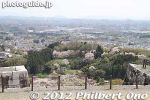
Marvelous views from Nihonmatsu Castle's Honmaru.
|
|
|
|
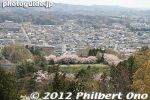
The city of Nihonmatsu as seen from Nihonmatsu Castle.
|
|
|
|
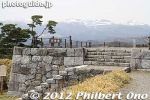
Stone foundation of the central tower or donjon.
|
|
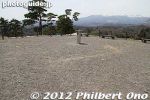
Stone foundation of the central tower or donjon.
|
|

Scenery guide on the stone foundation of Nihonmatsu Castle's central tower or donjon.
|
|
|
|
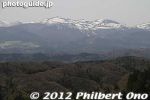
View of the mountains.
|
|
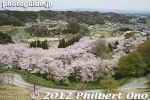
Marvelous views of cherry blossoms from Nihonmatsu Castle's Honmaru.
|
|
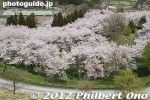
Marvelous views of cherry blossoms from Nihonmatsu Castle's Honmaru.
|
|
|
|
|
|
|
|
|
|
|

Kyu-Ninomaru Sumi-yagura Turret, an Important Cultural Property 旧二の丸隅櫓
|
|

Due to the Meiji government's castle destruction order, most of the castle moats were filled in except for this one next to the Honmaru. After World War II, US troops occupied the castle grounds for a short time..
|
|

Omotemon Gate, another Important Cultural Property
|
|

Omotemon Gate 表門
|
|

Omotemon Gate, one of two Edo-Era structures in Shibata Castle and an Important Cultural Property. 表門
|
|

Tatsumi Yagura Turret, reconstructed in June 2004. 辰巳櫓
|
|

Stone wall with perfectly-fitting stones. No gaps between the stones.
|
|

Sumpu Castle moat. The buildings are the Shizuoka Prefectural capital.
|
|

Bridge over the first moat.
|
|

Sumpu Castle is a short walk from JR Shizuoka Station. You'll find mainly moats, a large park, and some government buildings.
|
|
|

When Tokugawa Ieyasu retired as shogun, he lived here at Sumpu Castle. He also died here at age 72 in 1616. On the day of his death, his body was taken to Mt. Kunozan at Nihondaira for burial.
|
|
|

Tatsumi Yagura Turret (Reconstructed in 1992)
|
|

Statue of Yajirobe'e ("Yaji") on the left and Kitahachi ("Kita") from the story "Tokaido-chu Hizakurige" by Juppensha Ikku (1765-1839) a comic playwright who was born in Shizuoka city.
|
|

Yaji in front of Sumpu Castle in Shizuoka city. 「東海道中膝栗毛」十返捨一九
|
|

Kita in front of Sumpu Castle in Shizuoka city. 「東海道中膝栗毛」十返捨一九
|
|

Statue of Yajirobe'e ("Yaji") on the left and Kitahachi ("Kita") from the story "Tokaido-chu Hizakurige" by Juppensha Ikku (1765-1839) a comic playwright who was born in Shizuoka city. In front of Sumpu Castle.
|
|

Sunpu Castle has only two castle buildings, both reconstructed. This is one of them, the Tatsumi Yagura Turret. 巽櫓
|
|

Tatsumi Yagura Turret at the southeast corner of Sumpu Park. 巽櫓
|
|

Sunpu Castle's Tatsumi Yagura Turret and Higashi Gomon Gate.
|
|

Higashi Gomon Gate and bridge
|
|

Higashi Gomon Gate and bridge
|
|
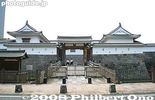
Sumpu Castle's Higashi Gomon Gate and bridge 東御門
|
|

Higashi Gomon Gate and bridge 東御門
|
|

About Sumpu Castle
|
|

Higashi Gomon Gate Bridge
|
|

Higashi Gomon Gate 東御門
|
|

Gate door
|
|

Higashi Gomon Gate 東御門
|
|

Stone wall of Higashi Gomon Gate
|
|

Higashi Gomon Gate 東御門
|
|

Higashi Gomon Gate
|
|
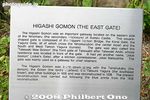
About Higashi Gomon Gate
|
|

Tatsumi Yagura as seen from behind.
|
|

Inside Tatsumi Yagura Turret
|
|
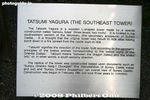
About Tatsumi Yagura
|
|

Castle tower stonework with the characteristic stone steps.
|
|

Central Yanai has a beautiful street of traditional buildings having traditional white walls (shirakabe). This area is also a National Important Traditional Townscape Preservation District (重要伝統的建造物群保存地区).
|
|
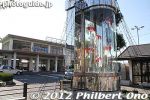
The white-walled street is called Shirakabe Machinami (白壁の町並み), a short walk from JR Yanai Station.
|
|
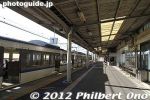
Train platform at JR Yanai Station.
|
|
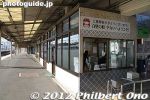
JR Yanai Station.
|
|
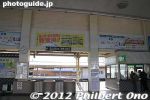
Inside JR Yanai Station.
|
|

Map of central Yanai.
|
|
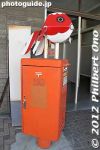
The goldfish is the symbol of Yanai, Yamaguchi. Here's on atop a mailbox.
|
|
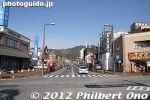
Road in front of JR Yanai Station. Walk straight on this road to the white-walled street.
|
|
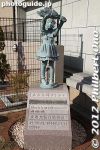
A few scupltures along the road to the white-walled street. Yanai, Yamaguchi
|
|

Directional signs in English.
|
|
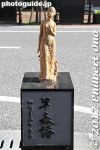
Yanai, Yamaguchi
|
|
|
|

About Yanai's white-walled street.
|
|
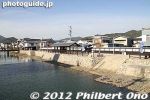
Cross the river.
|
|
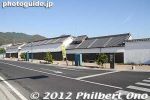
First you see Muroya-no-Sono, a longhouse museum.
|
|
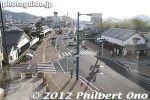
Street heading to JR Yanai Station.
|
|
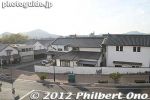
Entrance to the white-walled street. Even the private home on the right is white.
|
|
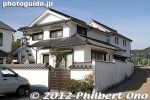
Private home blending in with the white-walled street in Yanai, Yamaguchi.
|
|
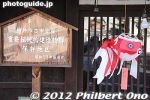
Sign indicating that this area is an Important Traditional Townscape.
|
|

About Yanai's goldfish connection.
|
|
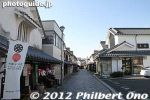
Walking along Yanai's white-walled street.
|
|

Yanai's white-walled street has a long history going back to the Muromachi Period (1337-1573). It used to be a merchant quarter. The street is about 200 meters long.
|
|
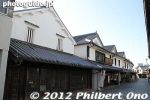
Buildings are beautiful and in unison. Very impressive. Most buildings are private, but there are a few tourist shops and homes open to the public.
|
|
|
|
|
|
|
|
|

This is the Kunimori family home, open to the public. Important Cultural Property. Admission 200 yen. Yanai, Yamaguchi Prefecture.
|
|
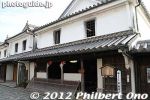
The Kunimori home is a former merchant's home. Open 9 am - 5 pm. Closed Mon.
|
|
|

About the Kunimori merchant's home.
|
|
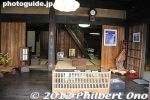
Inside the Kunimori-ke merchant's home.
|
|
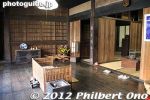
The Kunimori merchant's home is large and spacious. You can see how Edo Period merchants lived.
|
|
|
|
|
|
|
|
|
|
|

2nd floor of Kunimori merchant's home.
|
|
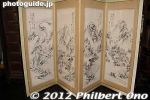
Folding screen
|
|
|
|
|
|
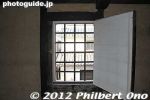
Window on the 2nd floor of Kunimori merchant's home..
|
|
|
|
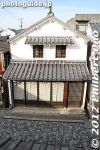
Yanai, Yamaguchi
|
|

Don't step on this.
|
|
|

Yanai, Yamaguchi
|
|
|
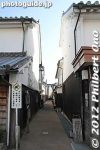
Narrow alley
|
|
|
|
|
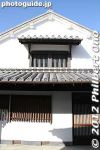
Yanai, Yamaguchi
|
|
|
|
|
|
|
|
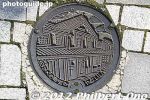
Manhole in Yanai, Yamaguchi based on the white-walled townscape.
|
|
|
|

Atago Jizo statue to protect against fires.
|
|

About the Jizo statue
|
|
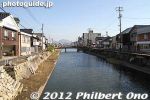
River runs parallel to the white-walled townscape.
|
|
|
|